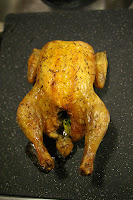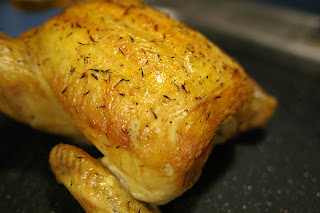 One of my favorite homemade meals is Family Pizza Night. I love that the kids are part of the process of making their own food. They get their own individual-sized pizza that they can "decorate" as they see fit - often making smiley faces with the ingredients. They get to choose what they want and how much they want. They get to have fun making good food and the whole dinner process is a family event. Our standard fare includes pepperoni, red bell pepper, mushrooms, and pineapple. Emma goes for mostly pineapple "eyes" and red pepper as a "smile". Jack and Linda tend to include a little bit of everything - Jack starts with a design, but usually ends up wanting to include too much so he has to forgo with his original idea. As Emma pointed out last time, I'm the most boring -
One of my favorite homemade meals is Family Pizza Night. I love that the kids are part of the process of making their own food. They get their own individual-sized pizza that they can "decorate" as they see fit - often making smiley faces with the ingredients. They get to choose what they want and how much they want. They get to have fun making good food and the whole dinner process is a family event. Our standard fare includes pepperoni, red bell pepper, mushrooms, and pineapple. Emma goes for mostly pineapple "eyes" and red pepper as a "smile". Jack and Linda tend to include a little bit of everything - Jack starts with a design, but usually ends up wanting to include too much so he has to forgo with his original idea. As Emma pointed out last time, I'm the most boring - As with all of my doughs, I make this one in the bread machine. I've found that this recipe is plenty for the whole family. After the bread machine has done its work, I cut the dough into three equal pieces and then cut one of the thirds in half - this results in two smaller pieces (one for each of the kids) and two larger pieces (one for each of the grownups). We usually have leftovers for lunch the next day (except me - who apparently doesn't think one piece will be enough for lunch so it might as well be eaten now). After trying several different recipes, I like this one best - I found it online, but can't remember where.
Pizza Dough
1 cup lukewarm water
2 Tbsp honey
¼ cup olive oil
3½ cups bread flour
½ tsp salt
2 Tbsp yeast (this is quite a bit of yeast - you can use less, but I like the rise and taste this much yeast gives)
1) Place all ingredients, in order, into bread machine (or use your standard dough-kneading technique and skip ahead)
2) Set on dough cycle - watch and amend with more water or flour as needed after 4-5 minutes
3) When bread machine is done, remove dough from pan and punch it down
4) Cut dough into individual servings, form each serving into a ball, cover and let sit for 15-20 minutes
5) Pre-heat oven and pizza stone (if using) to 400-450°
6) Roll, pull, push, toss, or otherwise shape your pizza dough
7) Top with sauce (we use our standard tomato sauce - Pastene Kitchen-Ready tomatoes), cheese and toppings of your choice
8) Cook until dough is slightly browned and cheese is melted and bubbly
9) Cool for a few minutes, cut, eat, enjoy
A tip that I find works really well - if you are going to use a pizza stone, make and cook your pizza on parchment paper. After a few minutes in the oven, you can easily pull the parchment paper out and let the pizza finish cooking directly on the pizza stone.


























